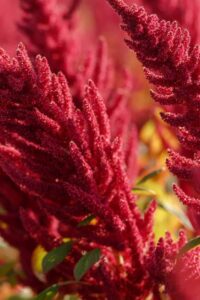
- Dt.inderjit.walia@gmail.com
- +91 89308-32001
Menu
Buckwheat (Fagopyrum esculentum), also known as kuttu in India, is a type of millet that has been cultivated for thousands of years. Despite its name, buckwheat is not related to wheat and is actually a member of the Polygonaceae family. It is primarily grown in temperate regions and is known for its unique nutty and earthy flavor, which makes it a popular ingredient in various cuisines.
In India, buckwheat is particularly valued during the Navratri fasting period, where it is often used to make traditional dishes such as kuttu ka atta and kuttu ki roti. The grain is also used in other recipes, including pancakes, porridge, and salads, due to its versatility and nutritional benefits.
Buckwheat is recognized for its health benefits, including improved heart health, better blood sugar control, and support for digestive health. Its high content of rutin, a flavonoid, helps lower blood pressure and reduce the risk of cardiovascular diseases. Additionally, buckwheat has a relatively low glycemic index, which means it has a minimal impact on blood sugar levels when consumed. The fiber in buckwheat supports digestive health by promoting regular bowel movements and preventing constipation, contributing to a feeling of fullness and aiding in weight management.
In recent years, there has been a growing interest in buckwheat as a sustainable and nutritious food source. Its adaptability to various climatic conditions and low input requirements makes it an important crop for sustainable agriculture. The grain’s ability to be stored for long periods also makes it an essential component of household food security and diet diversity during lean seasons and periods of food shortage.
Kingdom: Plantae
Order: Caryophyllales
Family: Polygonaceae
Genus: Fagopyrum
Species: esculentum

Herbs increase every year. When completely developed, stems are upright, 30-90 cm tall, scarlet or green in color, with glabrous or papillate patches on one side and above branching. The leaf blade is triangular in form, measuring 2.5 x 2.5 cm, and has veins papillating on both surfaces. The caducous, membranous, oblique, and non-ciliated ocrea measures around 5 mm. The petiole is between 1.5 and 5 cm long. Peduncles: 2-4 cm, papillate on one side; inflorescence: axillary or terminal, racemose or corymbose; green, elliptical, 2.5–3 mm, border membranous, 3- or 5-flowered bracts. Pedicels are longer than bracts and do not have flexibility. A pink or white perianth accompanies the elliptic, 3-5 mm tepals. Anthers have a pink tint. There is diversity in styles. The seeds that are greater in diameter than the remaining perianth are ovoid, five to six mm in size, dark brown, opaque, highly trigonous, and have flat surfaces. Fl. June-October; fr. September-May. 32 − 2n = 16.
